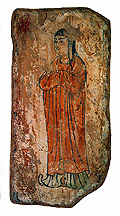
9th century
Khocho
Fresco
43.5 x 21 cm
Acquisition number: MIK III 6912
Image courtesy of the Museum für Indische Kunst (copyright reserved)
Staatliche Museen zu Berlin - Preussischer Kulturbesitz
The figure is that of a youth (the gender is not clear) dressed in a long, orange-brown robe with oversized sleeves. An under-robe of white extends from the bottom of the outer robe, covering the figure's feet. Only the turned-up point of the shoes is visible.
This fresco was removed from a small temple located outside the city limits of Khocho. The structure was originally thought to be bare of decoration, but when the outer walls of later date were removed, a series of wall paintings were exposed. These were of a type utterly different from both the Buddhist and Manichaean traditions, while also differing substantially from the type of painting found in Zoroastrian temples. For this reason, it is believed the frescos represent some of the few surviving examples of Nestorian painting in Asia.1
(1) Along the Ancient Silk Routes: Central Asian Art from the West Berlin State Museums (New York: The Metropolitan Museum of Art), p. 158.